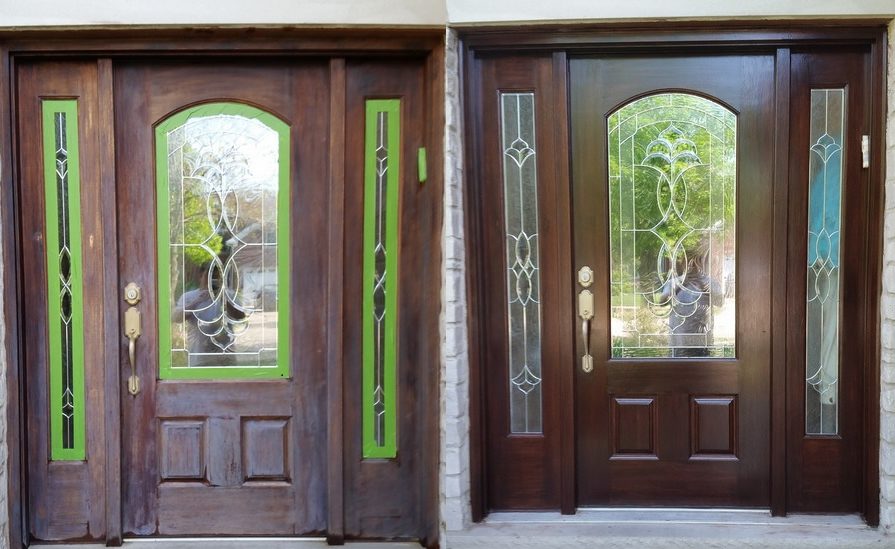
I remember shortly after moving in during 2009, during the “restoration” after our basement flooded, one of the repair workers commented that our front door needs to be re-painted. It turns out that the restoration company also does a lot of painting jobs. I hadn’t really paid much attention to how the door looked, as I wasn’t aware of many of the details in our house at that time. We have a nice wooden and glass front door, surrounded by two wooden framed glass panels. Even after he mentioned it, I didn’t pay too much attention as I figured he was just trying to get an additional job, as if the “restoration” wasn’t earning them enough money.
As time went by, though, I did start to worry that if I didn’t have our front door properly treated, that I could wind up having a much bigger expense. Since they seemed to do good quality work in the basement (although expensive), I figured I’d give them the first call for the door. I don’t remember exactly what options they gave me, but they ultimately suggested to have someone come out to paint it, and I would pay for the cost of the materials plus the painter’s time at a rate of $75/hour. That seemed reasonable enough and they sent out a young guy who brushed on something – I didn’t pay any attention to see whether it was a stain or a varnish that he applied. I remember thinking it looked better but I was more concerned with making sure whatever was applied would protect the door for the future. I have no clue if it protected the wood or not, but the cost was around $200 total which seemed reasonable for the guy’s time and materials.
Fast forward around seven years and my wife was commented on horrible the front door looked. The door has progressively gotten more of a white chalky appearance, sort of like a hazy coating over the door. My wife pointed out that none of the neighbors’ doors looked as bad as ours, even though our door faces North and doesn’t get much direct sun. The entryway is mostly covered, but I have to admit that when watering the front lawn, on windy days, sometimes water would get on the door. Or if it is raining and windy, it is possible the door got wet. My wife suggested we get it painted again, and I figured I would look up to see how complicated it can be to repaint a front door. Technically, I wasn’t looking to paint it, but to coat it in some way to protect the wood and make it look better, whatever that may entail.
I found an article that talked about how simple it was to re-stain a front door and varnish it without taking the door off or doing much sanding. The process sounded very simple, using gel stain and a varnish coating. I went to my local home depot to see what materials they had.
Home Depot didn’t have the brands recommended from the article, but I chose to buy Minwax Gel Stain as it was the only gel stain they carried. I chose the mahogany color, which seemed pretty close to my door’s original dark stained color. It was around $15 for a one quart size, which was plenty for my situation.
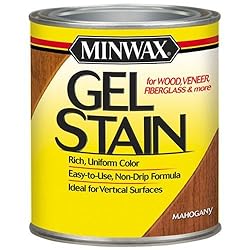
It appears they sell different types of Minwax gel stain – some for indoor use. The one I bought said it was fine for outdoor use, but it requires a top-coat using an exterior clear protective finish. The can suggested use of their must be top-coated with an exterior clear protective finish. For outdoor use, they suggest using their brand Helmsman spar urethane.
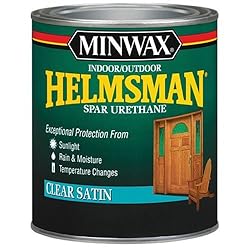
I purchased a quart, and it was around $17. I ultimately returned it for a non-urethane product after reading several reviews that said it started cracking or peeling within the first year of application. I then researched multiple other forums which suggested using a high quality spar varnish made with oil instead of urethane for better durability. I couldn’t find any of the oil based spar varnishes at local hardware stores, so I ordered from amazon. The most highly recommended spar varnish was Epifanes:
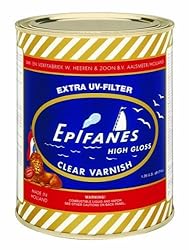
But I ultimately decided against Epifanes because almost everyone says you need to thin it with mineral spirits or paint thinner before applying, especially the early coats. They also suggest applying multiple coats – like eight coats, with full drying and then sanding between coats. It can take days to fully dry before you can sand it between coats. This was not something that was practical for my situation. I went with what was frequently rated as the second best product, McCloskey Man O’War spar varnish, selecting the satin color (I didn’t want too high of a gloss). Ordering one quart on Amazon was approximately $30 and came in about a week (since I don’t have Amazon Prime).

Going back to my Home Depot purchases, on my first trip, I also bought cheese cloth (around $5), three 2″ foam brushes (about $1 each), and some 100 grit and 220 grit sandpaper (around $5 each for multiple narrow sheets). The can of spar urethane recommended using a high quality brush to apply, so I splurged and bought a $12 2″ wide brush with white china bristles, recommended for applying oil based products and varnishes. I also bought some painter’s tape to mask off the windows from getting stain on them. They worker at Home Depot suggested the Frogman tape. The roll he pointed me to was around $9. There are narrower rolls available on Amazon that would have been fine and cost under $5.
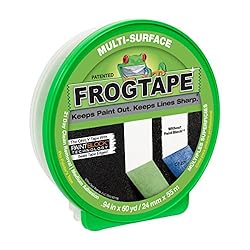
Now on to the actual work. I learned after the first coat of gel stain three very important lessons. First, wearing cheap nitrile gloves makes clean-up MUCH easier. Second, don’t forget to remove or tape the hardware on the door. Third, use a drop cloth. I’ll get to points two and three later, as I had to also learn how to do some cleaning up after the first coat of gel stain.
Before I started painting, I followed the advice in the article I linked to above. I first washed the door down with water and let it dry. While it was drying, I taped up the glass windows. Here’s the “before” picture of my door. You can see how horrible the chalky white surface had gotten on the door. The very bottom of the door is still a little wet in spots.
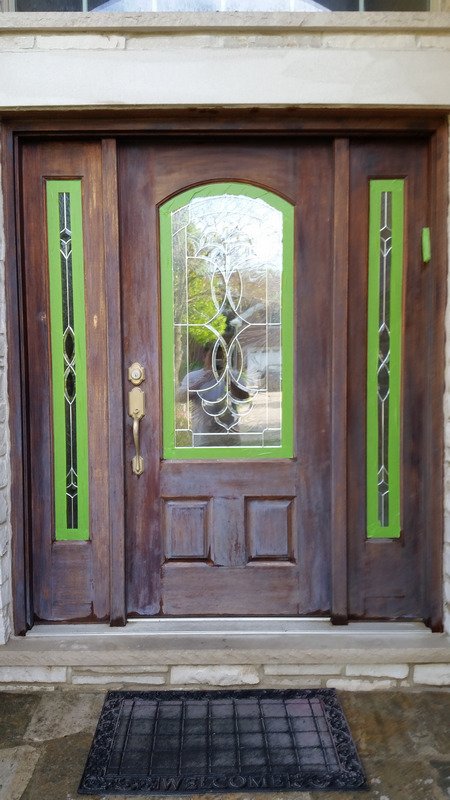
You will also notice that there are two light spots on the left window panel, around halfway up, one on each side of the glass. That was where we had a “no solicitors” sign taped. It turns out scotch tape is HORRIBLE when it comes to trying to remove it from finished wood surfaces. It was impossible to peel all of it off, and removing it ultimately took the finish off with it, even trying to lightly sand it off. If someone has a suggestion on how to safely remove scotch tape without ruining the finish, that advice would be greatly appreciated!
After I finished prepping the door as shown above, I got to work. First, I tried using the 100 grit sandpaper lightly over the door, but I found it seemed too harsh, scratching the previous finish more than sanding it. Perhaps it was my technique as I am out of practice, but I was much more comfortable sanding very lightly with the 220 grit sandpaper. I wasn’t sure how much to sand as I wasn’t trying to remove the previous finish. One big advantage of gel stain is that it will adhere to previous finishes. Traditional stains require the surface be complete free of previous stains and varnishes. The second big advantage is that you don’t have to remove the door – you can apply the gel stain while the surface is vertical.
I opened the gel stain, stirred it with some kindling wood I had around the house, and started applying it liberally with the foam brush, as instructed. The instructions say to leave it on for 3 minutes and then wipe off the excess. The cheese cloth did a great job, but I found that the cheese cloth got coated with stain very quickly and I had to be stingy with the cheese cloth in order to have enough for the entire door for the first coat. Wiping off with even strokes following the grain of the wood helps prevent streaking in the finish.
When I was done with the first coat, my hands were covered in gel stain. It was very difficult to remove from my hands. Regular soap did nothing. Things l like vegetable oil worked better. I wound up having the most success with hand sanitizer and a lot of scrubbing. Using nitrile gloves for future coats saved cleaning stain off my hands completely.
The door immediately looked better after one coat of the gel stain:
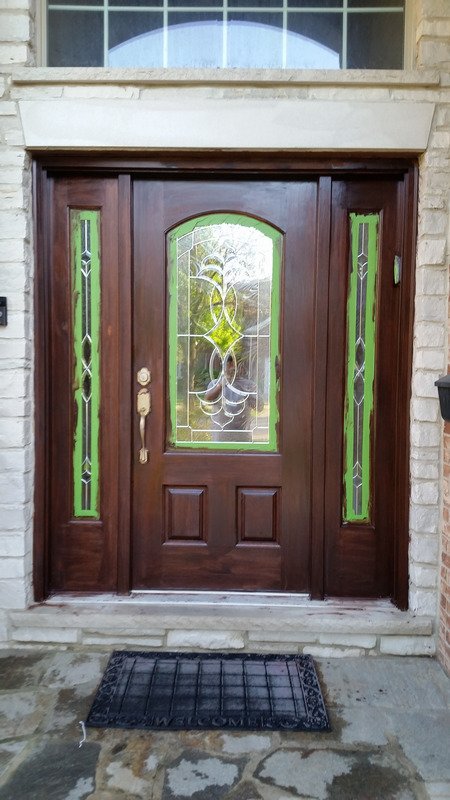
It already looked way better, but I was starting to get quite obsessed with the project. There were still parts of the door, especially on the lower half, that had the whitish cloudy haze over it, as well as some streaking in spots:
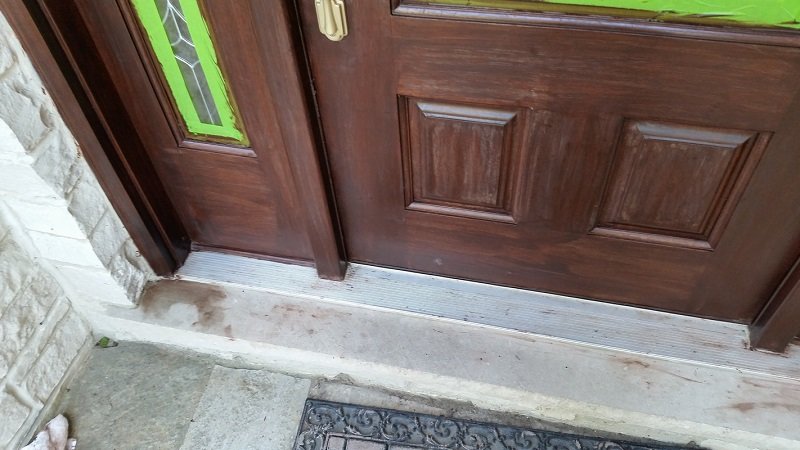
I decided to try the second coat to see if I could improve the whitish haze as well as get rid of some of the streaking. I went back to Home Depot as I needed more foam brushes (I used all three I purchased doing the first coat). I also needed more cheese cloth, but while I was there, one of the Home Depot staff convinced me to try the “wiping clothes” saying they were designed for that purpose. One pack included 10 pre-cut wiping clothes and was under $5. I also decided to buy the 10 pack of nitrile gloves, which was under $4. They have similar ones at Amazon for around $2.50 for a 10 pack.
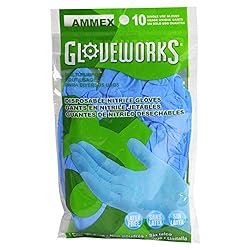
I also decided to get a drop cloth, because there was quite a mess of stain that dripped on the ground during coat #1. I think I was more careful for future coats, but sometimes things did still drip on the ground. A 9×12 drop cloth was around $2. Definitely worth it. I bought a few other items that I’ll either expound on at the end of this post or create a new post. It was items related to cleaning up the mess from the first coat – both on the hardware, the ground, and the stone next to the side panels.
Before I applied coat #2, I did clean up quite a bit of the mess on the ground, hardware, and stonework around the door. I also taped off the hardware this time, set-up the drop cloth, and put on the gloves. This time I was a little more careful when wiping off the stain to try to keep the strokes steady and even, with the grain, as I knew that there can be streaking if I’m not careful. At first I didn’t think the second coat added much, but I do think it helped some of the streaking. I was still having issues with the white haze though:
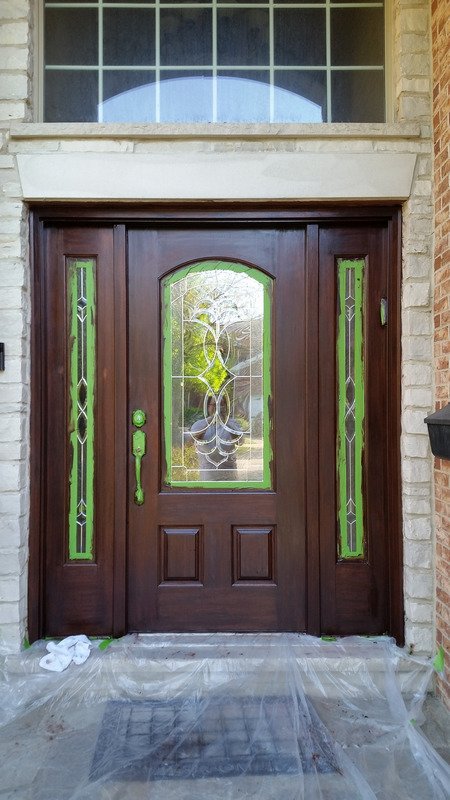
Here’s a closer look at some of the whitish markings, still present after the second coat:
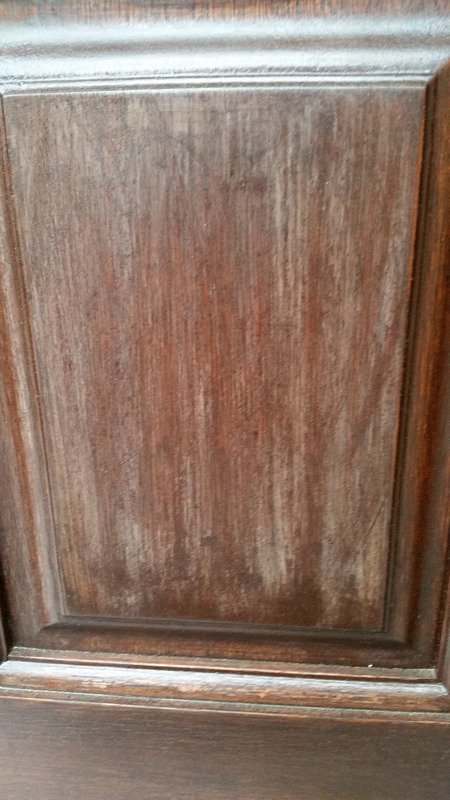
I decided I would try adding a third coat to see if I could get rid of that white chalky color. I first tried putting an extra coat just over the areas that were white. I found that if I wiped it off after the three minutes, it didn’t really seem that much better. I was starting to get frustrated that I couldn’t get rid of this whitish haze. I decided to try some different things. First, I tried leaving the stain on for about 10 minutes before wiping the stain off, instead of the recommended three minutes. This didn’t really make the stain noticeably darker, but what happened is that as the gel stain got tacky, it started to cause some lint from the wiping cloths to get pulled off and stuck into the stain. Oops. Fortunately, I was able to get most of the lint cleared out, but this was potentially very messy.
I then tried a few other approaches to removing the whitish coloring on the door. Looking things up, the internet seemed to suggest that the biggest problem was moisture, probably trapped between two layers of varnish, making it very difficult to remove. I was advised to try sanding out the finish until the whitish discoloration is gone, restain the wood, and then varnish. Hmm. So much for the easy way to refinish the door, but I wasn’t giving up on an easier solution just yet.
I tried to read as much as I could about this white chalky haze discoloration that was driving me crazy. This went from being a simple, quick job to something I was obsessed with fixing. I searched and searched the internet for a solution. The solutions I tried include the following:
- Holding a hot iron near the surface of the wood, trying to get any of the moisture to evaporate out (didn’t work)
- Covering the wood with a soft cloth and placing the iron on the soft cloth, trying to get any of the moisture to evaporate out (didn’t work)
- Covering the wood with a soft cloth and placing the iron on the soft cloth, but using the “steam” setting on the iron. I’m not sure why steaming the door would help, but there was one discussion where multiple people said that this helped. (didn’t work for me)
- Lightly wiping the surface with mineral spirits or paint thinner to remove the layer of varnish that is trapping the moisture (didn’t work).
- Wiping the surface with olive oil. I tried this in a small area and it may have helped slightly, but I also read that these types of oils don’t ever really disappear and can become rotten in time. I really didn’t want a door covered with rotten oil.
I wound up applying a fourth coat, and decided to not wipe it off as aggressively. I used very light pressure to wipe off the excess gel stain. The stain wound up a little darker (which I am fine with) and it seemed to do a pretty good job of covering the whitish haze. Finally, I’m reasonably satisfied with how the stain looked.
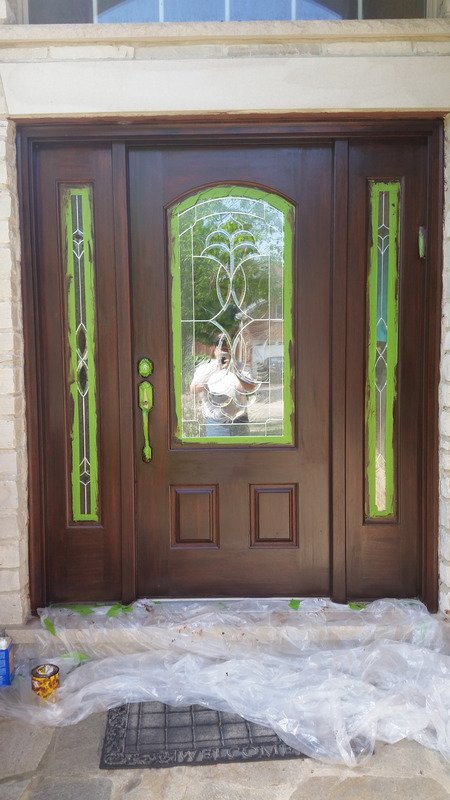
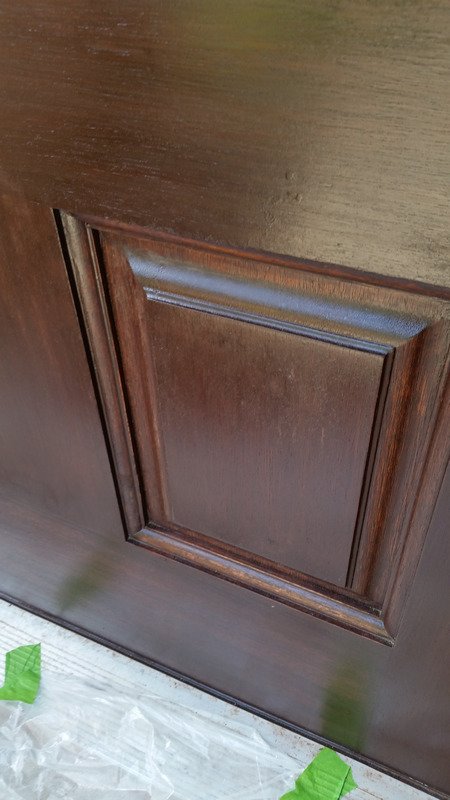
Now that I was satisfied with the stain, I decided to give the varnish a try. I tried to sand the gel stained wood with 220 grit sandpaper, but I felt that it was making too many scratch marks, so I wound up using very light pressure. I’ve read that you need some roughness to the surface for the varnish to best adhere. I had already decided that between coats, I would use a much finer grit sandpaper, and actually bought an ultra-fine sanding pad which is closer to a 600 grit to use between coats of varnish. I broke out the expensive white china bristle brush that I bought at Home Depot and opened the Man O’ War Spar Varnish.
Applying the varnish wasn’t too hard, but I did learn a few tricks that helped it go on smoother. First, I applied it with the grain. I agree with something I read about keeping a “wet edge”, meaning that you start applying the varnish to the dry wood and brush towards the area that is already coated. When lifting the brush off the wet varnish, it generally wouldn’t leave a streak. Where I started a brush stroke, though, would generally leave a streak. I realized that if I started at an edge and painted towards the middle where I’d overlap the previously varnished surface, it didn’t seem to leave any streaking.
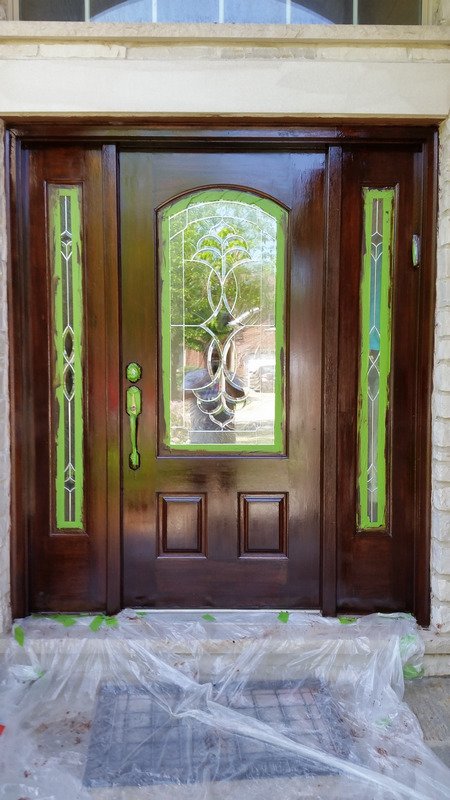
Right after I applied the first coat of varnish, I was concerned that the surface looked too glossy, but the gloss lessened quite a bit after the varnish dried. I also should have been more careful in certain places that I didn’t apply the varnish too thick, and I should have brushed off the excess right when it was starting to run. I wound up with runs in two places on the door – one run under the door handle and the other run underneath a grooved area of the door.
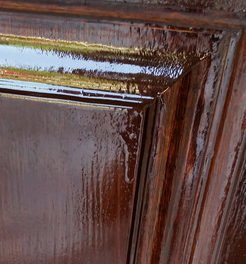
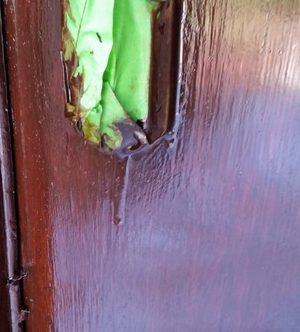
Corrected a run in varnish properly is very time consuming. You are supposed to wait for the run to dry completely, which can take a week or longer, given the thickness of that area. Once it is completely dry, you can sand it down to the surface before applying your next coat. I didn’t have time for that, as my work space had already been cluttered for well over a week. I decided to do my best to sand down the raised run, and just varnish over it. The varnish basically peeled off and left a slight edge between the varnished spot and the removed run. I very lightly sanded the remainder of the door, using an ultra fine sanding pad, approximately a 600 grit pad. I then just applied the second coat of varnish. The run shows if you look. Fortunately, the places this happened are relatively inconspicuous and no one else notices them.
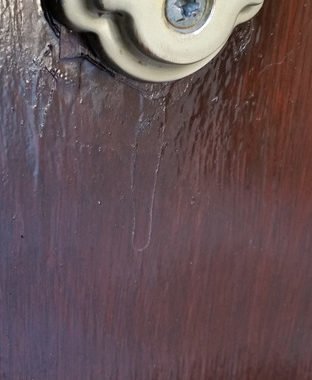
One surprise I had with applying the varnish was that it attracts a ton of these little green bugs. When the varnish is wet, they stick to it. As they try to free themselves, they leave marks in the finish. Reading up on this, it appears to be well known among people who apply spar varnish, and the recommendation is to wait until the varnish is dry and then just wipe the bugs off, sanding anything that doesn’t remove easily. Fortunately, they do come off very easily after the varnish is dry. Waiting was not easy, but trying to remove them while the varnish is still wet is a futile process and definitely would ruin the finish. It turns out that the varnish continued to attract these flies for about a week after it had dried. I’m guessing something in the oil used is appealing to this particular kind of bug.
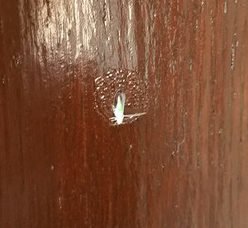
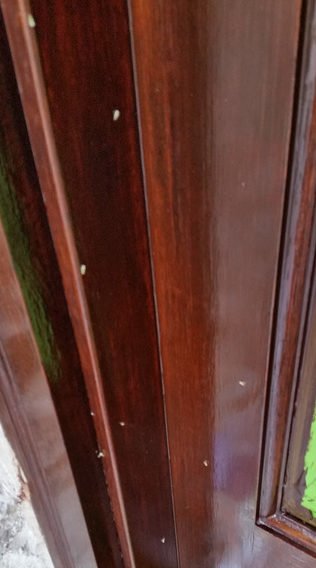
One other imperfection I don’t think anyone else has noticed is that when I taped off the hardware, there were some small areas where the tape covered the door. Here is a closeup where you can see the unstained and unvarnished layer next to the hardware. Makes for a striking before and after, but not really what I was going for.
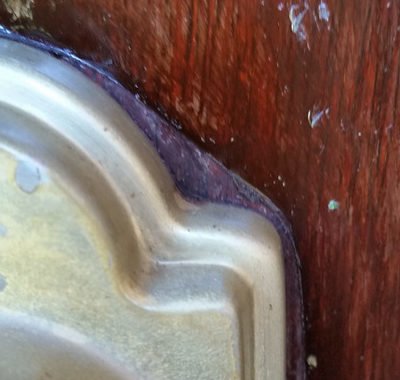
And finally the project is complete. I removed all of the tape and cleaned up everything as best as I could. I’ll probably do a separate post on the best way to clean-up the areas that had gotten stain on them – specifically the hardware before I taped it off.
Here is a picture of the door, a few days after applying the second coat of varnish.
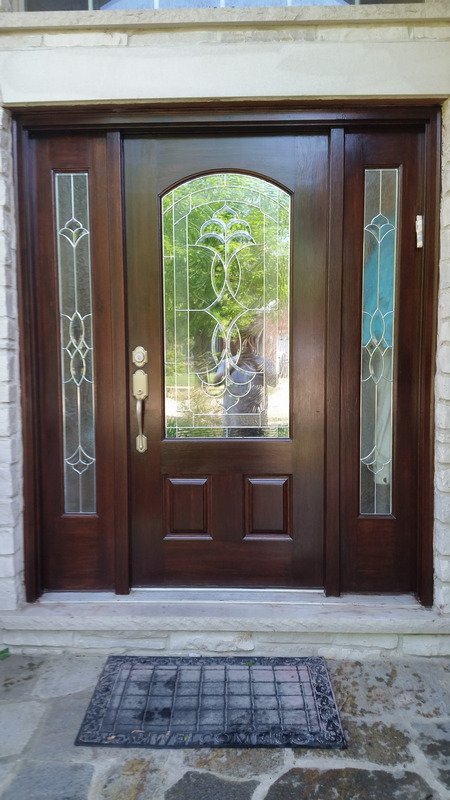
In conclusion, I’m very happy with how the door looks. The project took much more time than I expected but I also became much more intent on getting a great result instead of just an improved door. While it was time consuming, it was still far less time consuming and complicated than the traditional process of removing the door, sanding off the old coatings, staining the bare wood, and then applying varnish. I’m hoping that if the whitish discoloration was due to moisture between layers of varnish, that it doesn’t cause any problems down the road with the finish. I don’t expect it will, but time will tell. Regarding regular maintenance, I have plenty of varnish left and I’m fairly comfortable with applying it, if I decide to add another coat at some point in the future.